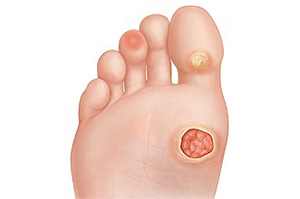Diabetic Wounds
 People with diabetes are at high risk of developing foot problems. More than half of diabetics lose sensation in their feet due to nerve or blood vessel damage and can hurt themselves without knowing it. Even the smallest of foot and ankle injuries, such as a blister or ingrown toenail, can lead to infection and tissue death.
People with diabetes are at high risk of developing foot problems. More than half of diabetics lose sensation in their feet due to nerve or blood vessel damage and can hurt themselves without knowing it. Even the smallest of foot and ankle injuries, such as a blister or ingrown toenail, can lead to infection and tissue death.
Ulcers and other diabetic wounds commonly form on the bottom of the foot and can easily become infected or lead to other serious complications. Ulcers may develop as a result of poor circulation, lack of feeling in the feet, irritation or trauma.
Diabetic Wound Treatment
Once a foot ulcer or wound has been detected, it should be treated immediately in order to prevent complications from developing. Diabetic wound treatment focuses on relieving pressure from the area and removing dead skin cells and tissue through a process called debridement. The wound is then medicated and dressed to prevent infection and promote healing. For more severe wounds, patients may be required to wear special footwear or a brace to relieve pressure and irritation to the wound.
Preventing Diabetic Wounds
To prevent wounds from developing, patients should avoid walking barefoot and keep blood glucose levels under control. Diabetic patients should have regularly scheduled appointments with our office to detect any abnormalities in its earliest stages and reduce the risk of serious complications. You should also examine your feet at home on a daily basis.
How To Check Your Feet
Below are tips to help you look for foot problems. Try to check your feet at the same time each day, such as when you get out of bed in the morning:
-
- Check the top of each foot. The tops of toes, back of the heel, and outer edge of the foot can get a lot of rubbing from poor-fitting shoes.
- Check the bottom of each foot. Daily wear and tear often lead to problems at pressure spots.
- Check the toes and nails. Fungal infections often occur between toes. Toenail problems can also be a sign of fungal infections or lead to breaks in the skin.
- Check your shoes, too. Loose objects inside a shoe can injure the foot. Use your hand to feel inside your shoes for things like pebbles, loose stitching, or rough areas that could irritate your skin.
Warning Signs
Look for any color changes in the foot. Redness with streaks can signal a severe infection, which needs immediate medical attention. Tell your doctor right away if you have any of these problems:
- Swelling, sometimes with color changes, may be a sign of poor blood flow or infection. Symptoms include tenderness and an increase in the size of your foot.
- Warm or hot areas on your feet may be signs of infection. A foot that is cold may not be getting enough blood.
- Sensations such as burning, tingling, or “pins and needles” can be signs of a problem. Also check for areas that may be numb.
- Hot spots are caused by friction or pressure. Look for hot spots in areas that get a lot of rubbing. Hot spots can turn into blisters, calluses, or sores.
- Cracks and sores are caused by dry or irritated skin. They are a sign that the skin is breaking down, which can lead to infection.
- Toenail problems to watch for include nails growing into the skin (ingrown toenail) and causing redness or pain. Thick, yellow, or discolored nails can signal a fungal infection.
- Drainage and odor can develop from untreated sores and ulcers. Call your doctor right away if you notice white or yellow drainage, bleeding, or unpleasant odor.
The doctors at Thomas Podiatry & Associates are experienced in treating a wide range of diabetic complications and aim to promote healthy feet through comprehensive patient understanding.
To learn more about diabetic wound treatment and other podiatric services in Crisfield, MD, please contact us at Thomas Podiatry & Associates at 410-749-0121 today to schedule an appointment. You can also visit our office at the TidalHealth McCready Outpatient Center along Hall Highway beside the Alice B. Tawes Nursing & Rehabilitation Center. Talk to our team today and we will gladly help you!





